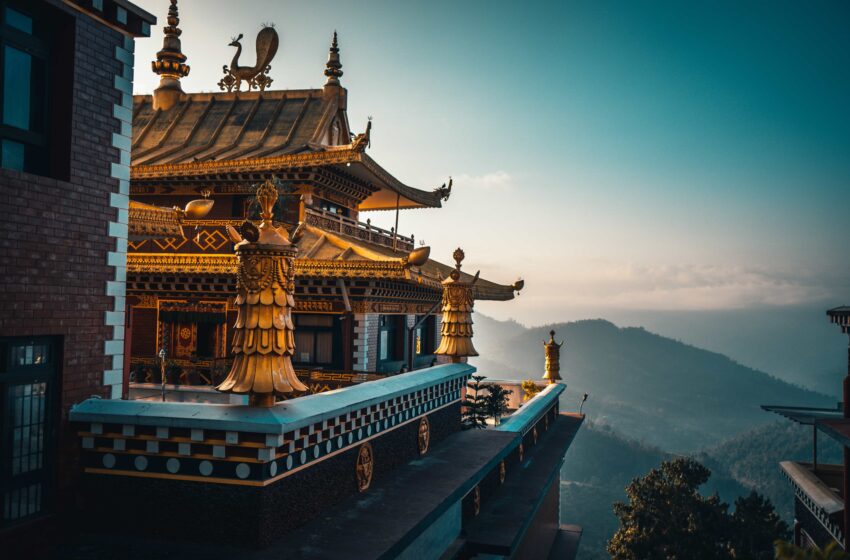
Bhutan’s Only Travel Guide You Need For A Great Trip in 11 Easy Steps
- Destinations Asia
Cruisit Team
- May 26, 2022
- 2
- 4670
- 79 minutes read
Bhutan’s Background
Bhutan was founded somewhere between 2,000 and 1,500 BCE. It is known as “Druk-Yui,” or “Land of the Thunder Dragon.” Bhutan is located in the eastern Himalayas of South Central Asia. It is bounded to the north by China and to the south, east, and west by India. Thimphu was the old capital. Until the late 1950s, Bhutan had limited interaction with the rest of the planet.
Britain and Bhutan signed the Treaty of Sinchulu in 1865, which provided for Bhutan to receive an annual budget in exchange for losing some of its borderland. Although Britain never colonized Bhutan, its armies were beaten in North Bengal, and the kingdom was forced to accept British control. In 1907, a monarchy was established; three years later, a treaty was made in which the British pledged not to intervene in Bhutanese domestic issues and Bhutan decided to allow the British to manage its international affairs. After 1947, independent India took this responsibility. Two years later, a formal Indo-Bhutanese agreement restored the British-annexed parts of Bhutan, established the country’s yearly subsidies, and outlined India’s obligations in defense and international affairs.
This fascinating Himalayan Kingdom is easily overlooked, much to our misfortune. Bhutan, on to those who are fortunate, can see how Bhutan is steeped in its beautiful Tibetan Buddhist roots and how fiercely it guards its culture. Tourism is heavily restricted, and the only way to visit is through an officially approved tour group. Bhutan, a tiny Himalayan country located between Tibet and India, is well-known for all the right reasons. The former king, Jigme Singye Wangchuk, emphasized gross national happiness during his rule. It is the only country that professes pleasure to be its ruling goal. Bhutan has long been recognized as the happiest country in the world, and it remains so.
Bhutan created the idea of Gross National Happiness to define a country’s success rather than Gross National Product. By law, at least 60% of the nation must remain forested for future generations; it presently exceeds 70%. Bhutan is not only carbon neutral, but it absorbs more carbon than it emits! This results in beautiful woodland excursions and excellent birdlife over a network of national parks. Whether you’re looking for takins or blue poppies, climbing under 7000m peaks, or walking through hillsides ablaze with spring rhododendron flowers, Bhutan is one of the Himalayas last untouched areas.
Bhutanese people, the majority of whom are Mahayana Buddhists, believe that a simple, sustainable, and healthy way of life is the path to happiness. It is not to be dismissed since, since 2010, thousands of visitors have flocked to the little country to discover what makes the people so pleased and contented.
Aside from traveling to discover the why and how of happiness, there is much more to discover. The scenery is stunning, and the weather is great at any time of year. Your experience begins even before you arrive at Bhutan’s airport. You’ll understand what we mean if you keep reading. Hint: (the section on how to get there – By Plane)
“The last great Himalayan kingdom, Bhutan, shrouded in mystery and magic, where a traditional Buddhist culture carefully embraces global developments.“
Because it is mandatory to enter the nation through a tour operator, you cannot travel there independently, not to mention that you pay a daily tariff. Bhutan is one of the most costly nations to visit due to the daily tariff (which ranges from $200 USD to $250 USD), but what you receive in exchange is a high-quality experience of a place that is unlike virtually anywhere else in the world.
While the fee may come as a surprise to many, $200 is not little change, especially when factoring in the word “daily” and “per person”. However, consider the tariff to be a minimal rate because it covers lodging, food, transportation, and an authorized guide. It is not a bad bargain. You are not compelled to travel in a huge group and, for an additional fee, you can go on your own timetable. Yet, what you will not find is low-cost independent travel.
If that isn’t persuasive enough, consider the pristine eastern Himalayan terrain, where snow-capped summits soar above virgin forests and charming traditional villages with intricately carved homes overlay the area. Add to it beautiful fortress-like dzongs and monasteries that serve as festival grounds and are teeming with medieval-looking people. The culture is fascinating, and the scenery is breathtaking. It’s not exactly ‘Shangri-La,’ but it’s close. When you put it all up, you’ll forget about the cost and think of it as paying for the privilege of seeing this mysterious, yet magnificent piece of land.
So take the leap, empty your bank account, and travel! Visit the Tiger’s Nest Monastery outside of Paro, the impressive Punakha Dzong (fortress-monastery), or feast your eyes on Wangdue Phodrang Dzong (aka the Wangdi Monastery), which began restoration in January 2014, watch locals stroll by in traditional clothing, hike a part of the Himalayas that isn’t trampled by tourists, and simply relax and enjoy the unforgettable scenery and tranquility of this hidden paradise.
This is an extraordinary place and well worth the visit. You will look back on your one week in Bhutan with admiration and you will dream of returning again someday. A country where the rice is red and chiles are the main component, not just a garnish (it can get really spicy). It’s also a deeply Buddhist country, with monks checking their smartphones after divination and massive penises painted at the gates to some houses. Bhutan, despite its pride in its Buddhist traditions, is not a time-bound place. Bhutanese people are well educated, entertaining, and well-informed about their surroundings (hint: the monk checking his phone). Bhutan’s fascinating blend of the ancient and contemporary is owing to this blend.
- Visit Taktsang Monastery, often known as the Tiger’s Nest Monastery; firmly affixed to the cliffs high above Paro.
- See Punakha Dzong, a superb example of a dzong, which are strongholds that have been converted into monasteries and administrative centers.
- Attend a celebration, called tshechu in Bhutanese, with stunning masked dances in the lovely setting of a monastery or dzong.
- Hike one of the many trails that Bhutan has. You will have it all to yourself!
- Count the stones holding down the traditional wooden roofs of Wangdi Monastery
- Walk around Thimpu (aka Thimbu), Bhutan’s capital, and visit the important Tashichho Dzong, or alternatively nearby Simtokha Dzong, the oldest in the country
- Go to Jakar, located in one of Bhutan’s most beautiful valleys and home to countless monasteries, including sacred Kurje Lhakhang
- Visit Bhutan’s rarely traveled wild east
- Cheer on the locals at an archery contest, held on most weekends almost anywhere in the country
- To obtain a visa for Bhutan, you must first arrange a tour, which costs between $200 and $250 each day (at the time of writing) depending on the season, group size, and other considerations. All lodging, food, hiking equipment, and freight for camping expeditions are included, as well as a guide, driver, and automobile.
- If you want a guide for yourself and do not want to join a group, you must pay an additional $40 each day, or $30 for two individuals. The advantage, of course, is that you can personalize your tour.
- Bhutan has around 1,000 licensed tour guides. How do you decide which one to pick? Almost all operators will assist you in obtaining visas to Bhutan, scheduling transportation into and out of Bhutan, and customizing your itinerary. So, do some internet research to pick a tour company with whom you are comfortable. Prices vary, so you may be able to save some money if you select one over the other. Bridge to Bhutan is one of the most highly rated trip providers.
- Be aware that if you don’t believe the lodging is worth $200 per day, it probably isn’t, but you are paying for the right of entry, not the kind of housing!
- Men must wear a collared shirt and long pants to access the temples. Women must dress in long slacks or a long skirt and a long-sleeved shirt. Both men and women must wear shoes and socks. Shorts, caps, and flip-flops are prohibited items of clothing. You must remove your shoes every time you visit a temple. You will do this four to five times a day on some days. We recommend wearing shoes that are simple to put on and take off.
- Bhutan is a peaceful and calm country in general. That is…during the day. At night, the countless stray dogs scream and growl for hours, often just outside your motel window. Packing an earplug is almost a must.
- Dancing and partying are frowned upon, particularly in public. This is a traditional and conservative country, and failing to maintain etiquette may result in difficulties.
- Most of the activities include trekking, which can be tiring, especially for persons who have health issues that limit their ability to participate in such activities. Because you’re trekking, you may get altitude sickness and shortness of breath. You should always keep a liter of oxygen in your bag.
- This is not a nation where you can tour independently.
Crime & Scams in Bhutan
Bhutan is most certainly one of the safest nations on the planet. The country has a low crime rate, which might be attributed to Buddhism, a faith that emphasizes compassion and nonviolence. Violent crime is exceedingly rare, especially against foreigners, however small crimes such as pick-pocketing are occasionally reported. There have been some reports of drug misuse, and alcohol consumption is an issue.
Healthcare in Bhutan While Traveling
Bhutan is home to around 30 hospitals. Traditional and classical medicine are both widespread in Bhutan, and patients can choose their own treatment approach. While healthcare is free for its citizens, it will not be for you, which is why we recommend you bring insurance with you. Bhutan’s constitution prioritizes health-care quality and adheres to conventional processes, treatment, and therapy criteria. Nonetheless, the country lacks comprehensive health care.
Before every trip, make sure you are up to date on all routine vaccinations. Among the key recommended vaccines globally are chickenpox (Varicella), diphtheria-tetanus-pertussis (DTP), influenza (flu), measles-mumps-rubella (MMR), polio, and shingles. Obtaining immunization cards for Yellow Fever, Hepatitis A and B, Typhoid, Rabies, and Meningitis is important when traveling.
You are not required to purchase travel medical insurance when visiting Bhutan. However, complete medical coverage is always recommended when traveling because you never know what you could face when abroad. This is especially true when visiting a distant nation with few extensive healthcare options. You may require emergency evacuation, and unless you have insurance, being in such a circumstance might endanger your life.
Shoulder Season
December through February is the Winter and marks the Shoulder Season. You may enjoy some stunning views of the Himalayas during this season, but you must be prepared to deal with the chill in the air. Highlights: This is the best time to visit Bhutan if you want to avoid crowds because it is one of the seasons with the fewest visitors. During the winter months of December, January, and February, Bhutan may get fairly cold, and snow can fall in central and eastern Bhutan. In the months of January, February, and December, the day rate is $200 per person.
High (Peak) Season
Bhutan has two main tourist seasons: spring (March to May) and fall (September to November). The months of March, April, October, and November are particularly busy. If you intend to visit during these months, book your tour package and plane tickets at least three months ahead of time. During this time of year, the weather is usually clear, with pleasant days and cool nights. During this time, the daily tariff is $250 USD per person.
Off-Season
The monsoon, which lasts from June through August, is the Low Season. This is a time when you just cannot visit Bhutan, despite the fact that housing expenses are at their lowest and you will most likely have the country to yourself with no other guests. From June to August is the off-season. Wet weather is expected throughout the summer months of June through August. Having regular rain showers, sometimes multiples per day, during this time of year is unusual, although they usually have no effect on travel. You may not be able to obtain the immaculate blue sky seen in these images. In the months of June, July, and August, the day rate is $200 per person.
Bhutan’s Tourism Council sets the daily tariff for all visitors entering the country. Except if you are from India, the Maldives, or Bangladesh, it is not feasible to enter Bhutan as a tourist without paying this price. All that is required of visitors to these three nations is their national identity card. The only alternative way to visit the nation is to be invited by a Bhutanese citizen, for which proof of relationship must be shown while applying, or through a non-governmental organization (NGO).
By Plane
Paro International Airport is the best and only option to enter the country by plane. It is located around 7 kilometers from the city and is served by the national carrier Druk Air as well as the private airline Bhutan Airlines. It’s a thrilling ride at around 5 kilometres above sea level. Your heart will skip a beat in your throat when the little turbo-prop jet of Druk Air drops out of the sky, banks left abruptly to miss a massive mountain range, and aligns to the runway with little than half a mile to move.
There are 2 to 6 flights every week from India to various destinations such as New Delhi, Kolkata, Bagdogra, Gaya, Mumbai, and Guwahati. Kathmandu Tribhuvan International Airport in Nepal is 1 hour and 20 minutes away, with 6 flights every week. There are also three weekly flights from Dhaka, Bangladesh, daily flights from Bangkok, Thailand, and two weekly flights from Singapore.
By Train
Bhutan has no direct train routes. Tourists must arrive at the designated station and then take a cab or local transportation to Bhutan. New Alipurduar, Siliguri, New Jalpaiguri Station, and Hasimara are the most convenient and finest alternatives from India. Your border possibilities are Phuentsholing in Southwest Bhutan, Gelephu in Southcentral Bhutan (250 kilometers from Thimphu), and Samdrup Jongkhar in Southeast Bhutan (700 kilometers from Thimphu, approximately three days journey).
By Car
Overland travel from Nepal to Bhutan is available via India. Overland travelers will leave Nepal at Kakarbhitta and go to one of three border crossings between India and Bhutan. Phuntsholing is located in the west, Gelephu is located in the center, and Samdrup Jongkhar is located in the east. There are no border crossings available along China’s northern border. To cross into Bhutan and return, you would require a multiple entry visa to India. Road permits are also necessary, but they are handled by your local tour operator in conjunction with your visa.
By Bus
Buses to Bhutan are solely available to Indian visitors. They leave Kolkata and reach Phuentsholing after 18 hours. The Bhutanese government provides these buses. Buses from Siliguri and Phuentsholing also run into Bhutan.
By Bus
Bhutan has no railroads, therefore public transportation is only offered by bus in places with metalled roads. Buses are typically packed and unpleasant, exacerbated by bad road conditions.
By Private Transport
All tour operators already provide hotel and airport pickup and drop-off services as part of your booked plan. Because your local tour operator will supply a car and driver for the duration of your stay, there will be no additional payment (included in the daily tariff). However, if necessary, transport by local or inter-district bus or cab can be arranged. Because public transportation between towns in Bhutan is few, hitchhiking is a widespread mode of transportation. The thumb in the air gesture, on the other hand, is not recognized, and you must flag down a passing car to ask it to stop.
By Car
Because Bhutan has limited roadways, parking on the main road is forbidden. b. Because Bhutan lacks traffic signals, giving way to police or emergency vehicles is necessary. Driving your own car in Bhutan is thus a welcome alternative to public transportation, which takes twice as long. In Bhutan, you are permitted to drive with a valid driving permit and the International Driver’s Document of IDL Services Inc.
Bhutan has two telecommunications companies: B-Mobile and TashiCell. Bhutan Telecom owns and operates B-Mobile. TashiCell is a privately held company. The country has a lot of 2G coverage. Outside of the capital, the 3G network is adequate but inconsistent. Both carriers are deploying 4G/LTE. Good plans start at 49 BTN for 425 MB for 7 days from B-Mobile or 49 BTN for 340 MB for 7 days from TashiCell, both of which are more than enough for the duration.
You also have the option of purchasing a prepaid eSim card like from Airalo, SimCorner, or Nomad. The companies provide data-only plans to put on a phone that is eSim ready, so make sure your phone is compatible. It is also possible to opt-in for a WiFi Hotspot from Solis. Check before you travel because they service certain destinations. Airalo by far has the most coverage of almost 180 countries.
Local Internet & WiFi
The internet and wifi, which are provided in most hotels around the country, are never an issue. The network connection is a touch slow, but it suffices for basic internet browsing.
Top Places in Bhutan

Paro Taktsang
Guru Padmasambhava meditated and taught Vajrayana in one of thirteen caves in Tibet. A second monastery complex was erected around the cave in 1692, and it has since become a cultural icon of Bhutan. His mausoleum is also known as “The Shrine of the Guru with Eight Names.” This temple, erected beside a 1,200-meter cliff, is one of the most significant Buddhist sites in the world and one of Bhutan’s most visited
Punakha Dzong
The Punakha Dzong, also known as Pungthang Dewa chhenbi Phodrang, is one of Bhutan’s most magnificent monuments. It was erected in 1637–38 by Ngawang Namgyal, the first Zhabdrung Rinpoche, and holds the precious relics of the Kagyu school of Tibetan Buddhism’s southern Drukpa Lineage. The dzong is a proposed UNESCO World Heritage Site and served as the seat of the Government of Bhutan until 1955, when the capital was relocated to Thimphu.
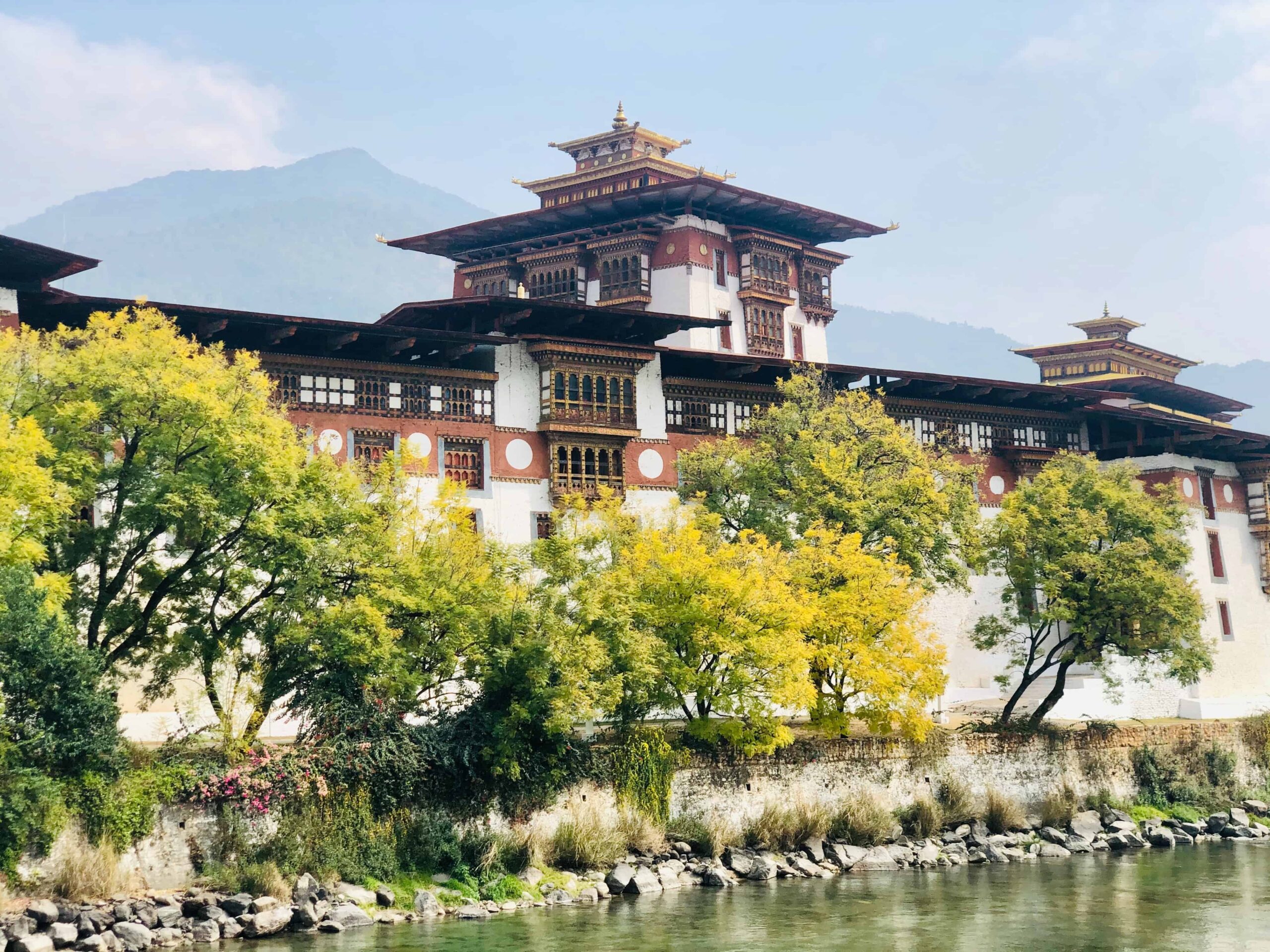
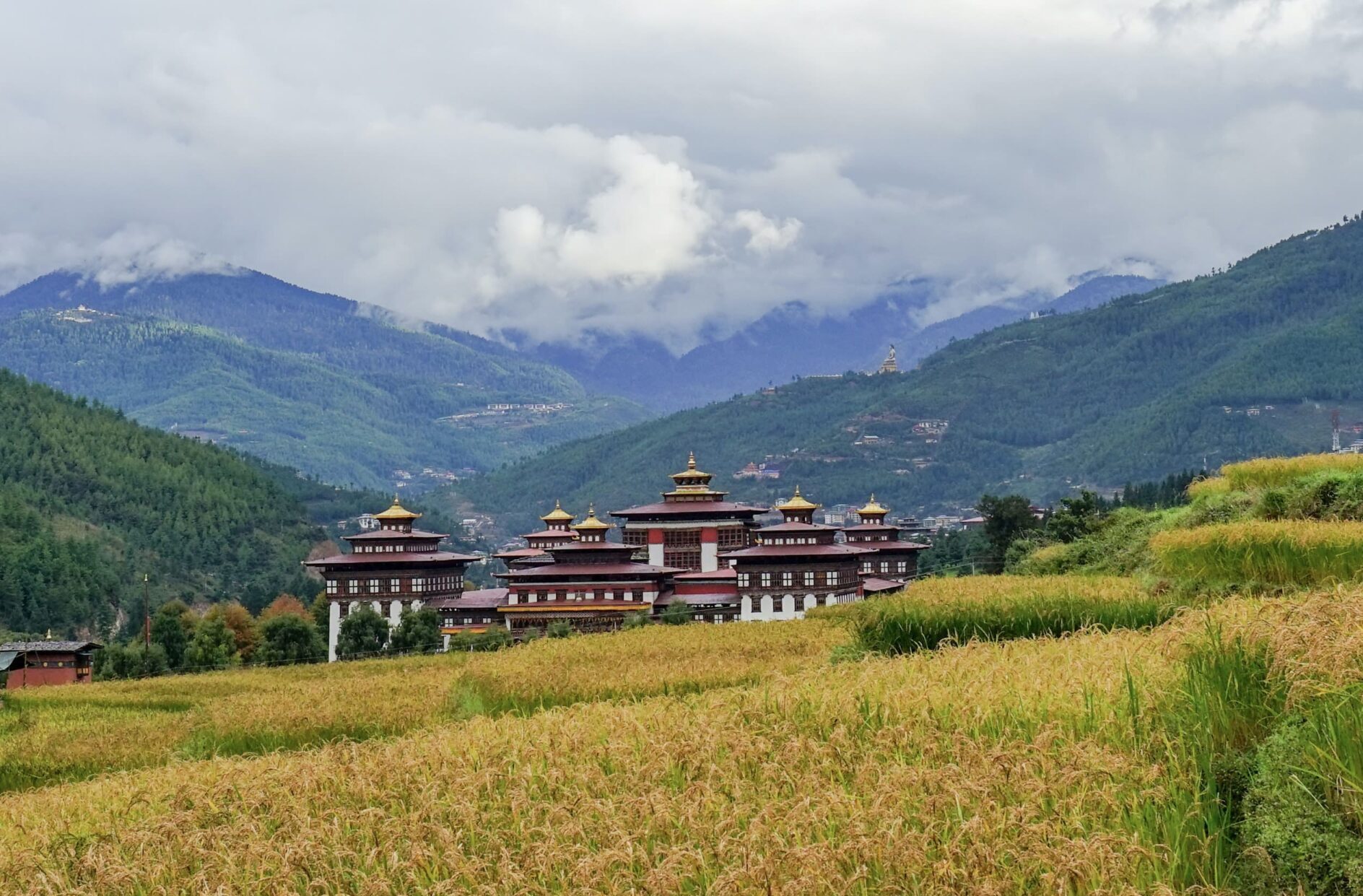
Tashichho Dzong
Tashichho Dzong is a Buddhist monastery and castle located on the western bank of the Wang Chu in Thimphu, Bhutan. It was erected by the first Dharma Raja, who established the Lho-drukpa sect of Buddhism, which has remained Bhutan’s separate sect. The whitish building’s main construction is two stories tall, with three-story towers at each of the four corners, capped with triple-tiered golden roofs.
Great Buddha Dordenma
The Great Buddha Dordenma is a massive Shakyamuni Buddha statue in Bhutan’s highlands. The completed sculpture is one of the world’s largest Buddha rupas, standing 169 feet tall and containing over a hundred thousand tiny Buddha figurines. Aerosun Corporation of Nanjing, China, financed by Singaporean billionaire Rinchen Peter Teo, built the monument for US$47 million.


Royal Manas Park
Bhutan’s Royal Manas Park has an area of 1057 square kilometers and is home to a diverse range of wildlife. The national park’s southern boundary is shared with India’s Manas Tiger Reserve. This park is home to a variety of endangered animal species, including one-horned rhinos, Bengal tigers, clouded leopards, Himalayan black bears, and others. There are also rare golden langurs and Gangetic dolphins can be seen here. This is Bhutan’s oldest wildlife park and has everything a wildlife fan might want.
7-day Itinerary in Bhutan (with extension options)
Day 1
Arrive in Paro and off to Thimphu
You can see how beautiful Bhutan is from the air before you even step foot there. Take in the vista of Bhutan as you enter the Himalayas from your window. It is one of the most beautiful flights you will ever take. The views of the Himalayas from the air as you travel to Bhutan from Kathmandu are stunning.
The majority of visitors will travel to Bhutan from Bangkok, Delhi, Kolkata, Kathmandu, or Singapore. Druk Air and Bhutan Airlines are the only airlines that fly to and from Bhutan.
The Paro Airport is one of the most difficult places on the planet to land an airplane. The runway is located in a narrow valley between steep mountain peaks, making it difficult to align the airplane with the runway. Only a few pilots are permitted to land here. You will meet your guide for the week at the airport and begin your trip of Bhutan.

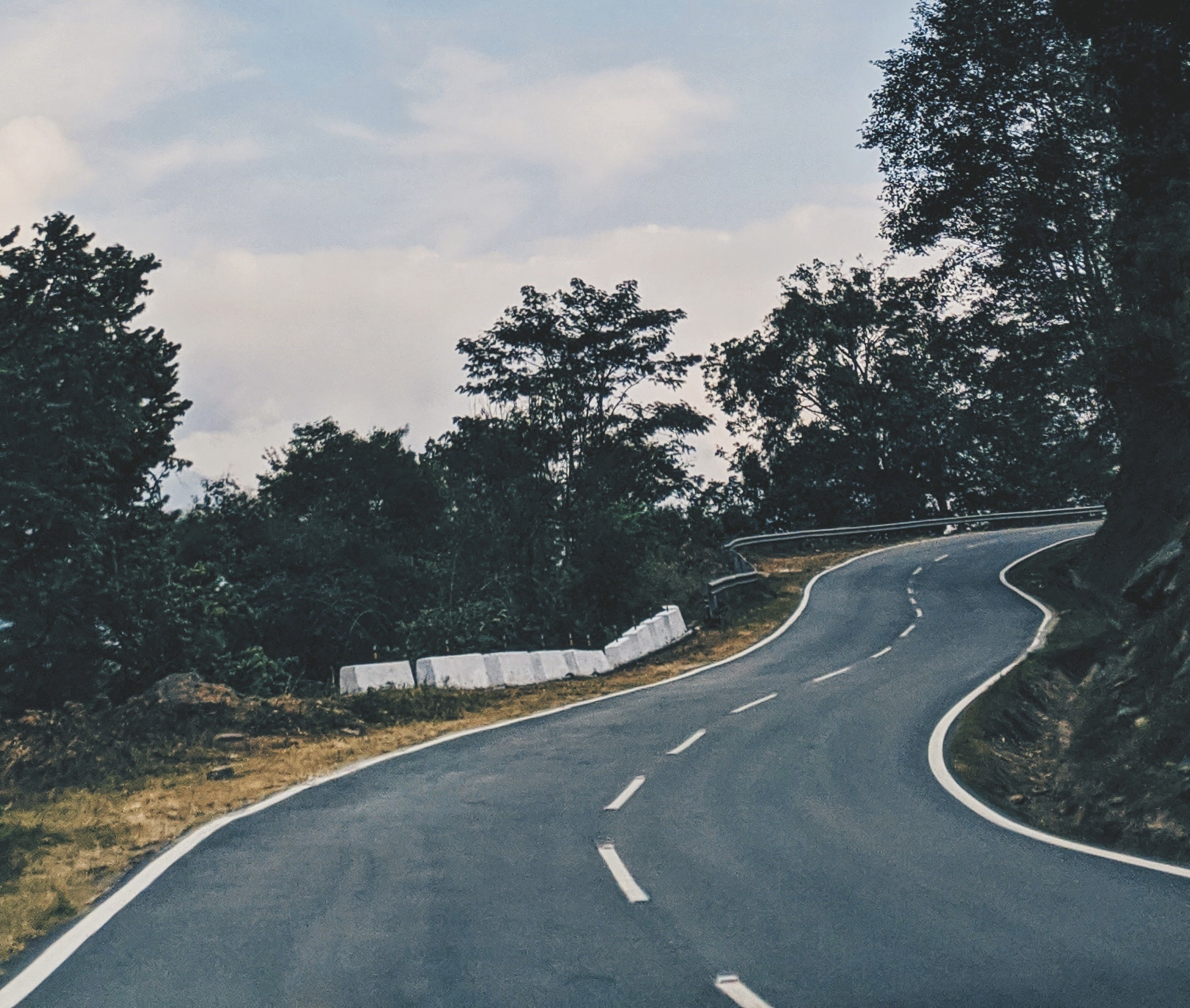
Thimphu, Bhutan’s capital, is a 45-minute drive from the airport. You will have your first taste of Bhutanese cuisine when you stop in there for lunch. Traditional dishes include red rice, noodles, meat with carrots, different vegetables, and green chilies with cheese. Chili peppers are used in many Bhutanese recipes, so be prepared for spicy food!
The city of Thimphu is where you will spend the afternoon. For a capital city, it is a little area. Thimphu is a lovely, colorful city set in a picturesque setting of blue sky, green mountains, and rice fields.
You can visit a local school where young adults learn creative skills like painting, weaving, embroidery, and woodworking.
Custom stamps featuring your photo can be ordered from the Bhutan Post Office for avid stamp collectors, that is something! You can also get normal stamps.
Head to the Takin Preserve, where you can see the Takin, Bhutan’s national animal. When you’re done, dinner and peace will round off your day.


- Backpacker:
- Budget:
- Mid-range: Hotel Pedling
- High end:
This section will be added shortly.
From the Airport to your accommodation
By Train
By Bus
By Metro
Day 2
First Treks, Monastery visits, and Archery
After breakfast, drive up into the highlands to the Cheri Monastery. This is likely to be many people’s first visit to a Bhutanese Buddhist monastery.
The trek up the slope to the monastery takes 45 minutes to an hour from the parking lot. Spin the prayer wheels, explore the temple, and learn about Buddhism and the monastery from your tour guide.
When you’re through, you’ll most likely want a snack or a proper meal. After lunch, you have the option of visiting a paper plant in Thimphu. Learn how to make handmade paper and color it with various dyes.


Next, visit the National Memorial Chorten, one of Bhutan’s most renowned religious sites. Every day, many Bhutanese people visit this Chorten to spin the prayer wheels and walk all the way round it. This boosts their positive karma, giving them a better chance in the future life.
After that, proceed to Tashichho Dzong. This amusingly named location is the highlight of the day. A dzong is a stronghold, akin to castles seen in Europe. Dzongs are now utilized as both a seat of administration and a monastery. It’s lovely to go around the courtyard of this dzong. It’s a lovely place, with a mix of tourists, tour guides, and Buddhist monks. 1000 Buddhas are painted on the walls of the temple.
Bhutan’s national sport is archery. You can see young males during a practice session if you are lucky with your time. They shoot hunting bows at a target 145 meters distant (that’s a long distance!). Then back to Thimphu, finish the day with dinner.

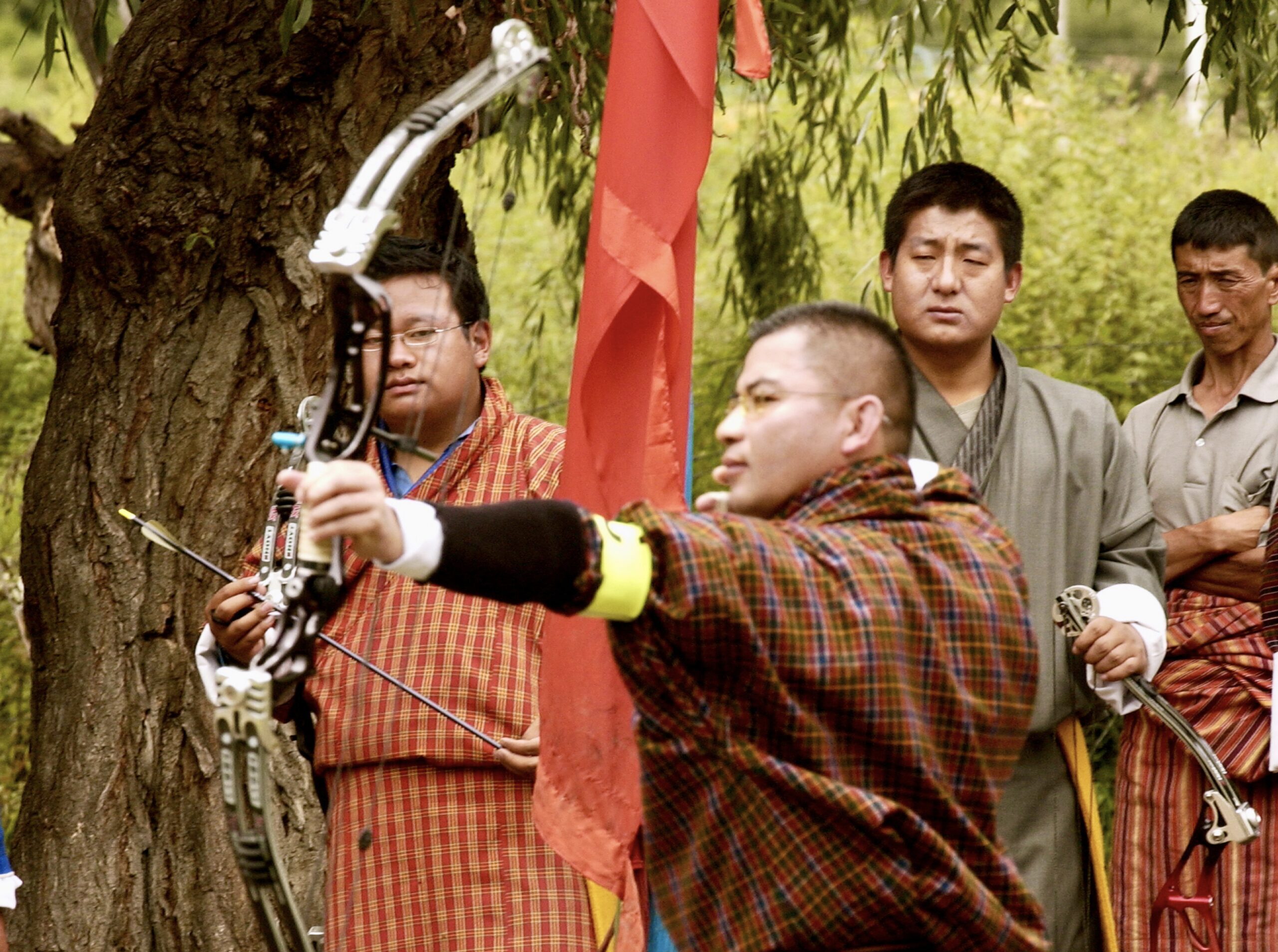


Day 3
Buddha Statue then off to Punakha
The Buddha Dordenma Statue, the world’s biggest Buddha statue, is the first stop after breakfast. It is composed of copper, gold-gilded, and contains 125,000 tiny golden Buddha sculptures. Why create such a massive, elaborate statue? The Buddha Dordenma monument was erected to celebrate Jigme Singye Wangchuck, Bhutan’s fourth King, on his 60th birthday. This statue may be seen on a hill overlooking Thimphu. Take one final look at Thimphu before departing towards Punakha.
The distance between Thimphu and Punakha is only approximately 85 kilometers. This journey, however, can take a long time because you will be traveling up and over a mountain pass on extremely windy roads. Travel durations are now shorter due to recent renovations (about 2 to 2.5 hours) on the improved quality roads.

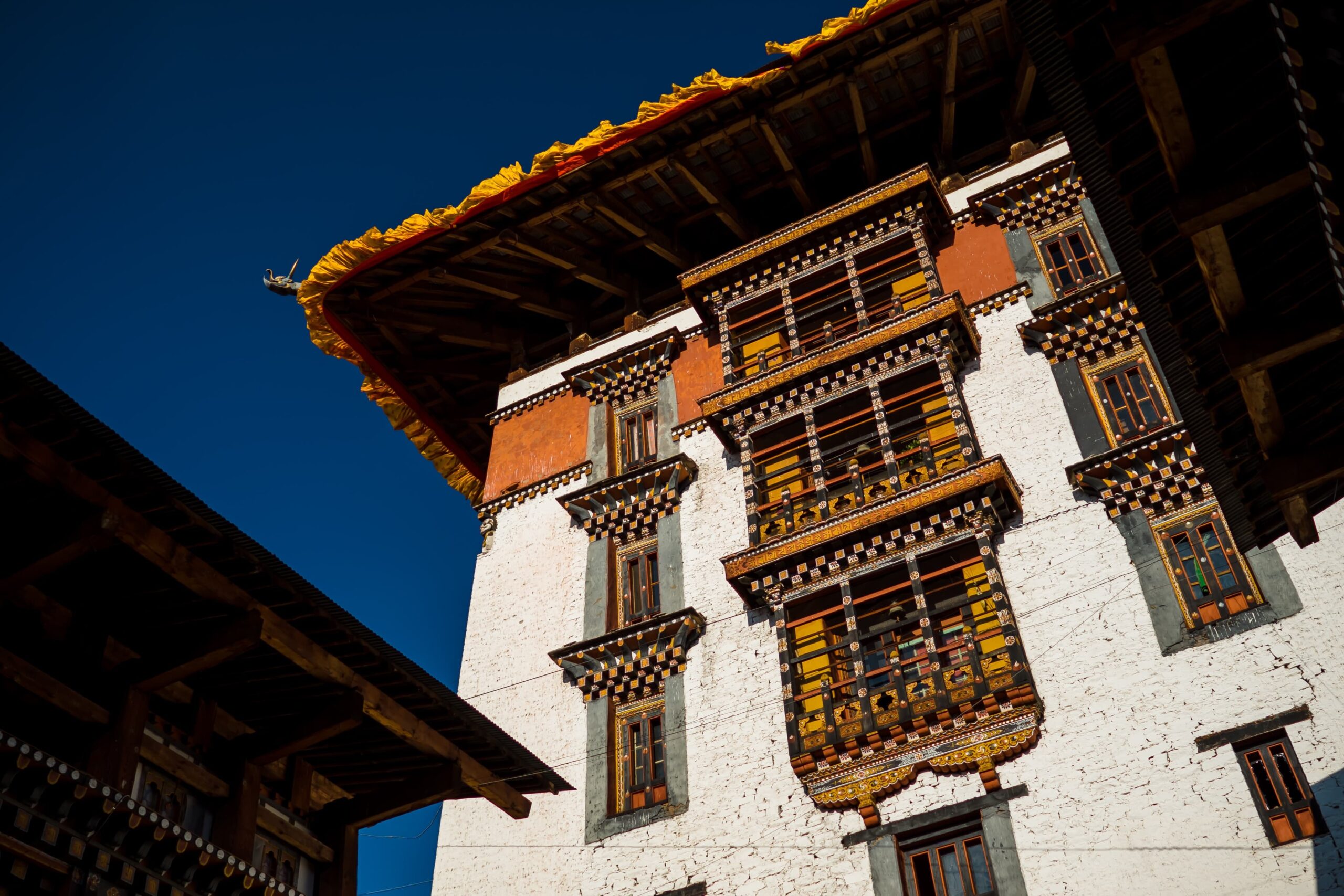
If you suffer from motion sickness, take your anti-nausea medication before leaving Thimphu. This journey is quite windy, and you may become green by the time you reach at Punakha. Dochu La Route connects Thimphu with Punakha via a steep mountain pass. The Himalayas are beautiful from 3,150 meters (10,330 feet). There are also 108 stupas along this pass as a memorial to Bhutanese troops murdered by Indian rebels in 2003.
It’s only a short ride to the Punakha Dzong after lunch. What a sight to behold!! One of the most spectacular dzongs in Bhutan. Cross the wooden bridge to the fortress and stroll the courtyard, enjoying the beautiful woodwork and learning more about Bhutan history and culture from your guide.
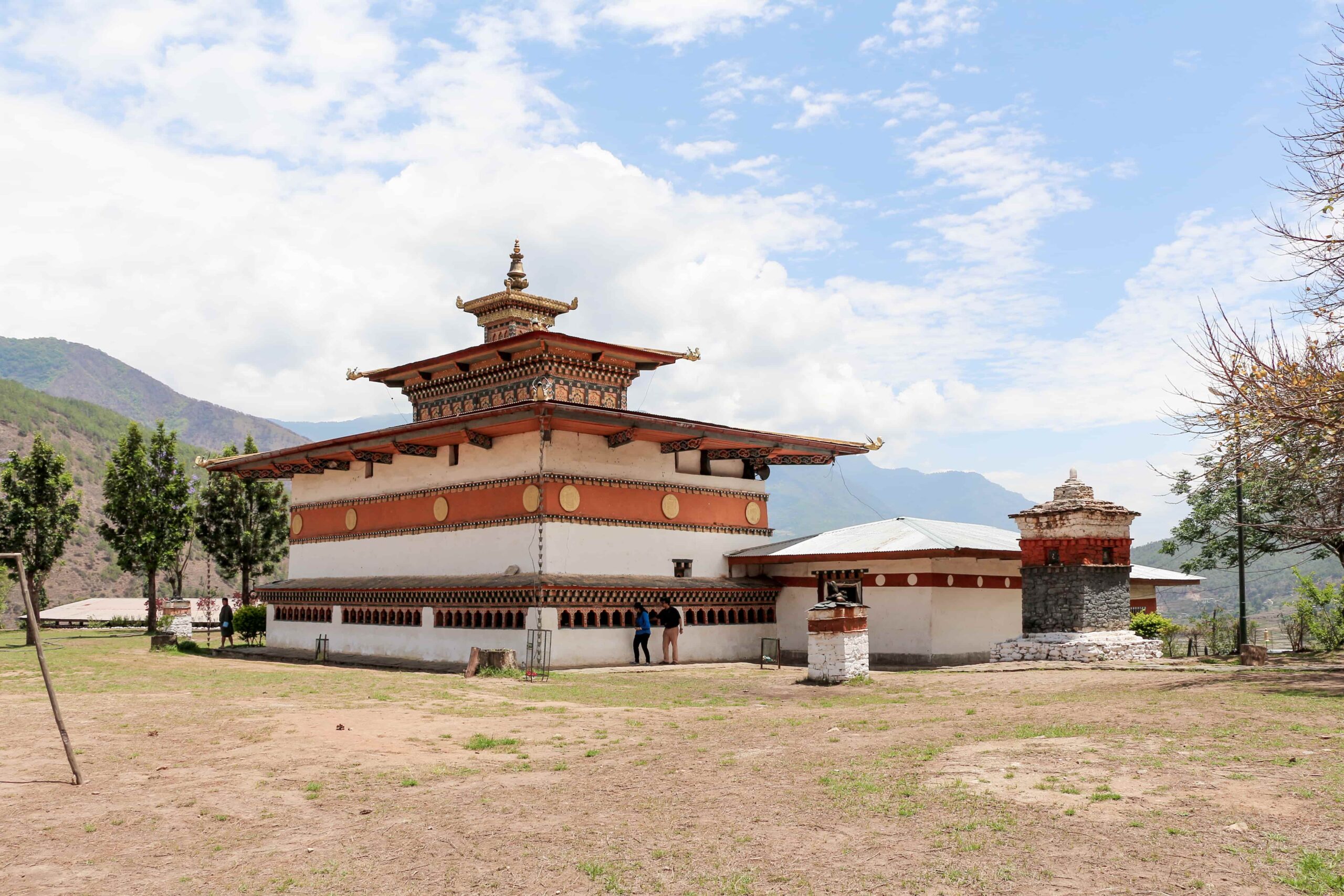

The next site may be startling to some, but it provides an intriguing glimpse into one of Bhutan’s cultural features. The Temple of the Divine Madman is known as Chimi Lhakhang. The Divine Madman was a Buddhist monk who adored ladies and booze. Chimi Lhakhang is currently a fertility temple, and childless couples come here to be blessed in order to boost their chances of becoming pregnant.
As you go from town to temple, you will pass through buildings decked with massive phalluses and stores selling phallic souvenirs. It can spark some intriguing discussions, especially if you come with youngsters. Inside the temple, you can be blessed with a bow and arrow as well as a foot-long wooden phallus. This is done for good luck and to ward off evil spirits.
Finish up the day with a meal in town or at your hotel.
- Backpacker:
- Budget:
- Mid-range: Lobesa Hotel
- High end:
Day 4
Rafting and Drive to Paro
Going white water rafting on the Mo Chhu River is a thrilling experience in Punakha. The date of your travel to Bhutan will have a large impact on whether or not this is achievable. The river is rather calm in October. However, rafting the Mo Chhu River in the spring is a considerably bigger experience.
Your guide will take you upriver for around 45 minutes from Punakha. Before you go rafting, stop at Khamsum Yulley Namgyal Temple. This temple is a short, lovely stroll across the rice fields. The view across the valley and the river you’re about to float on is breathtaking from there.

Wear your life jackets and hop onto your raft from the Khamsum Yulley Namgyal Temple. You cruise down the Mo Chhu River for approximately an hour, occasionally encountering larger rapids. Because the water flow might be low, it can be more of a relaxing journey down the river than a thrilling adventure, but it is still a fantastic experience. If you’re in luck and in the right season, this ride can get you your adrenaline fix. The Punakha Valley is stunning, and this is a unique way to see it. Gliding past the Punakha Dzong is a once-in-a-lifetime event.
It’s a lengthy journey to Paro after lunch in Punakha. Take those Dramamine tablets as needed, and try to enjoy the picturesque journey. The trip from Punakha to Paro takes about 3 to 4 hours.




Days 5
Back in Time in Paro
After a delicious breakfast, visit Bhutan’s top museum, The National Museum. There are thangkas (Buddhist artwork), ancient items, and festival masks within this round stone edifice. The view of the Paro valley will most likely be your favorite part of the museum tour.
Then proceed to the Paro Dzong. Admire the architecture and continue spinning the prayer wheels. Visits to these dzongs and temples might get monotonous in certain respects, yet they are all distinctive in some manner. Furthermore, you never know what you’ll see or who you’ll meet.
Visit Kichu Lhakhang next, one of Bhutan’s oldest temples dating back to the 7th century.
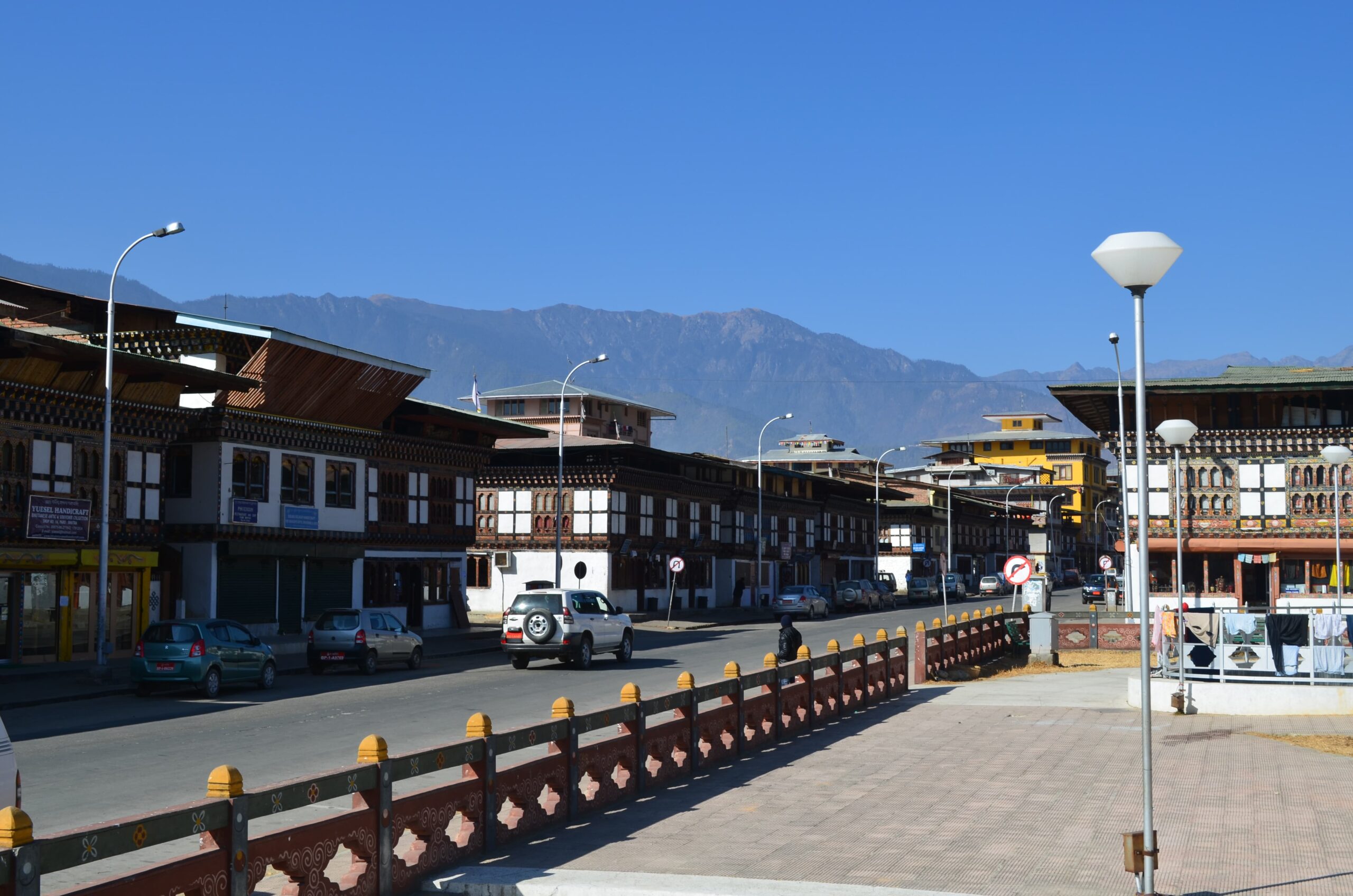
You will go out to Drukgyel Dzong after lunch, just when you thought there couldn’t possibly be another dzong to visit in Bhutan. These are the remnants of an old dzong that was destroyed by fire in 1951. It’s an interesting place to visit, and you can see the Tiger’s Nest monastery from the road.
Spend the remainder of the day shopping in Paro before finishing the day with supper in town.
Day 6
The Tiger’s Nest
The spectacular climax of your Bhutan trip is a trek to the Tiger’s Nest Monastery (Takstang Monastery). This monastery is one of Bhutan’s icons, and a trip to Bhutan would be incomplete without visiting it for yourself.
The Tiger’s Nest Monastery is a tiny group of structures placed perilously on a cliff 900 meters above the earth. Hiking is the only method to reach the Tiger’s Nest. A typical visit lasts 6 to 8 hours, including time to trek to the monastery, see the monastery, and have lunch. It’s an unforgettable experience and many people’s favorite thing to do when visiting Bhutan.
Finish the day with dinner in Paro and get ready for the your departure day tomorrow.
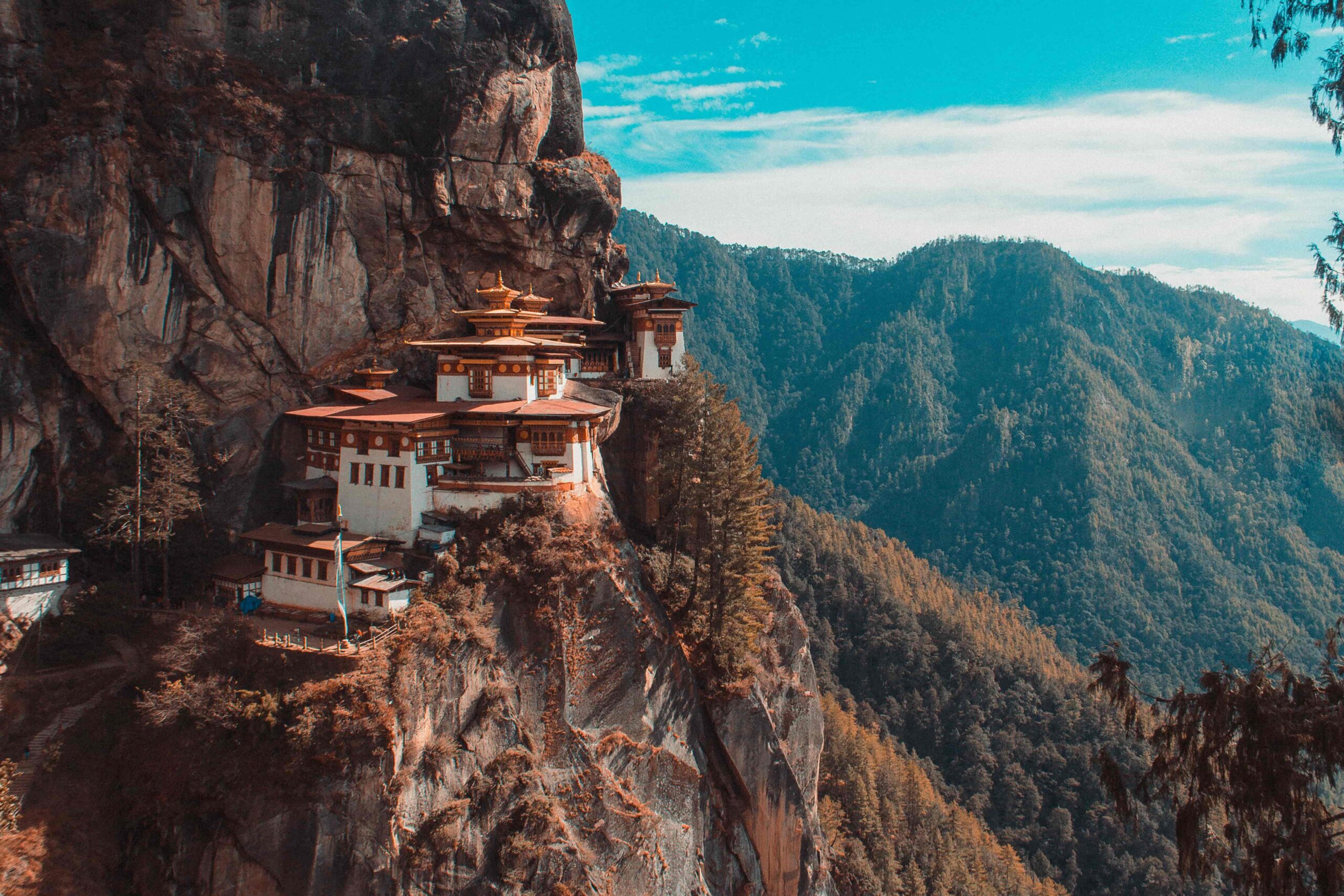


Day 7
Fly Home or Continue the Journey
You’ll start your journey home today. Alternatively, people with more time may want to continue their adventure.
The Most Popular Food in Bhutan
Bhutanese food is heavily inspired by Tibetan cuisine, but also by Chinese and Indian cuisine. Don’t be shocked to see mountains of rice offered as it’s the country’s major staple. White and red rice are also cultivated. Red rice has a nutty flavor if you wanted to know. Bhutan grows corn and wheat, the latter of which is used to produce noodles. Tomatoes, turnips, onions, greens such as spinach, green beans, chili peppers, and radishes are among the vegetable used in Bhutan. Flavorings are frequently applied, and many stews and meals are spicy and scorching. Curry, cardamom, garlic, turmeric, and ginger are the often used spices.Meats like beef, chicken, pork, yak, and goat are common in the cuisine, but vegetarian dishes are popular among Buddhists.
Bhutanese food, however, has one dominant flavor: chili, which holds a specific spot in the hearts and minds of people. If you enjoy spicy food, this may be something you enjoy about Bhutan. Because chilies are considered a vegetable, this little red spice is not only added to every dish but is also frequently consumed raw. Chilies may even be drying in the sun on the houses along the roadside. The chili peppers are frequently eaten with cheese. It’s rather hot and takes some getting used to, but it’s certainly worth trying when in Bhutan.
If you don’t enjoy spicy-hot cuisine, let your server know ahead of time. Otherwise, you’ll be dousing your tongue with cold yogurt or milk for the next hour. Rice is a necessary component of every meal. The accompanying cuisine consists of vegetable or meat dishes cooked with chili and/or cheese.
Many people enjoy Bhutan, however other individuals loathe the food, particularly those who dislike spicy food. Bhutanese food may be quite bland, with chili peppers added to give some spiciness. Of course, this is dependent on where you eat. Hot-pot and Western European cuisine are also available at select Thimphu restaurants that sell French fries, pig or beef ribs, and pizza.

Ema Datsi
Ema datsi, which literally translates to “chili with cheese,” is Bhutan’s most popular meal. Chilis, oil, salt, garlic, onion, and ginger are used to make it. After thoroughly frying, add the cheese and let it melt for a few minutes. Because each cook infuses their own magic into the meal, no two ema datsis are ever the same. Bhutanese cheeses are well-known for their variety and are frequently used in meals such as datshi. When you visit Bhutan, you will most certainly have ema datshi not only every day, but almost every meal. The chilies, which can be either fresh green or dried red, are sliced lengthwise and fried with datshi, a Bhutanese cheese accompanied with plenty of butter.
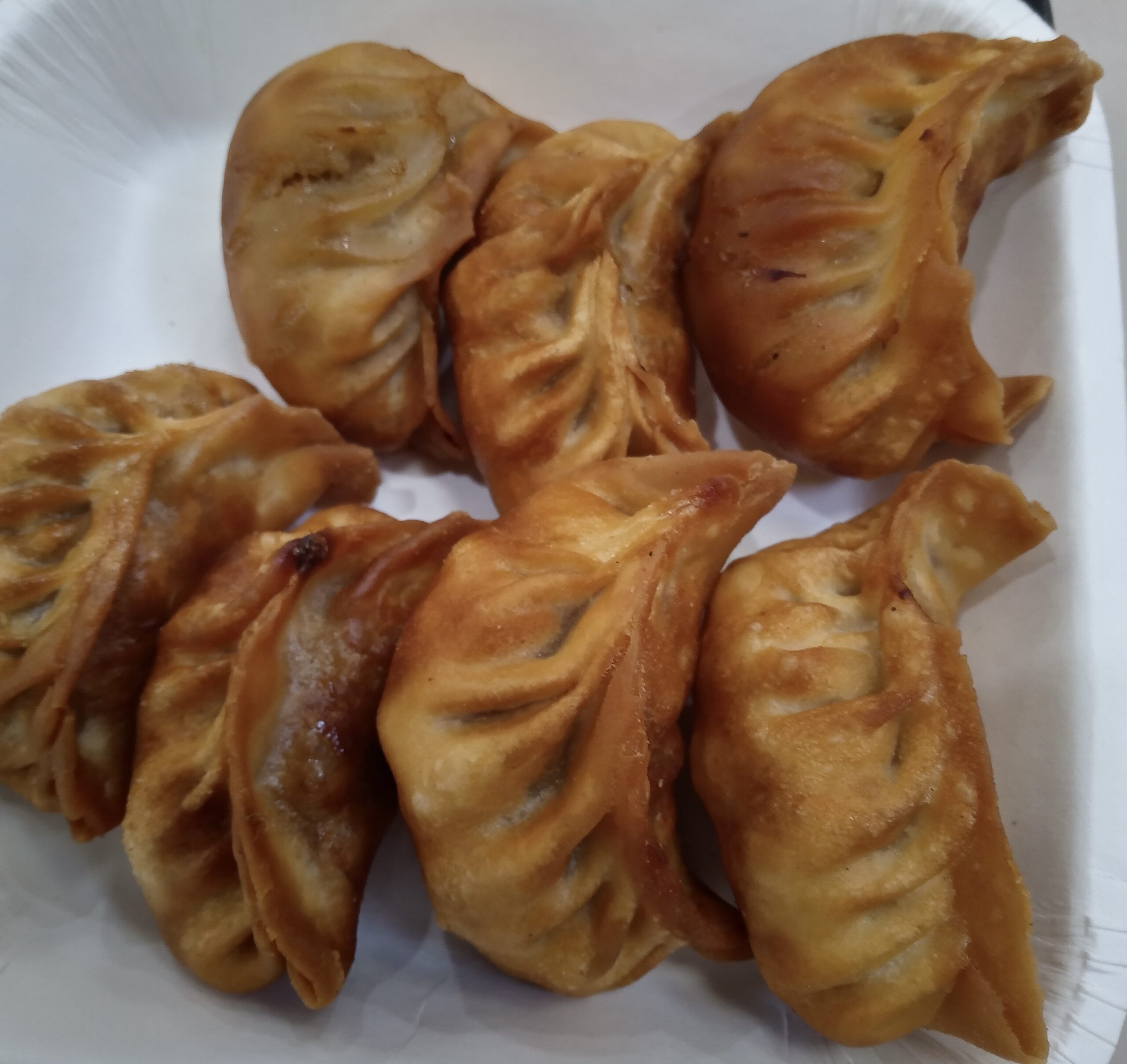
Momos
Momos are dumplings that are popular in India, Tibet, Nepal, and Bhutan. They are recognized as a Tibetan delicacy – presumably originating in China (dumplings), and the entire Himalayan area consumes them. They are served hot, stuffed with minced meat, cheese, or vegetables, and accompanied by copious amounts of Bhutanese chili sauce called as ezay. There are steamed momos and fried momos for whatever your taste buds desire. Momos are abundant in Bhutan, and can be found nearly anywhere: on the streets, in little eateries, and in expensive high-end restaurants.

Shakam Paa
Shakam Paa is a favorite dish among Bhutanese people. Dried beef is prepared with dried red chilis and, on occasion, radish. The meat is dried and stored in such a way that it tastes similar to beef jerky but is thicker and not fully desiccated. Shakam datshi (dried beef) is chopped into bite-sized pieces and cooked with cheese and butter. The chilis are frequently thrown in whole, allowing the fiery flavor to permeate the entire piece of meat. If you haven’t noticed, there’s almost no way to eat Bhutanese food without eating a lot of cheese, and this location is no exception.

Bjasha Maroo
Bhutanese spicy chicken stew is a favorite among locals. It’s made with leeks, garlic, onions, ginger, and, of course, green chilis! Boiling chicken bones with salt yields chicken stock. The meal can be topped with chili flakes and Ezay, a hot Bhutanese sauce, for an extra fiery sensation.

Kewa Datshi
Kewa datshi is a combination of potatoes with Bhutanese cheese that may taste quite similar to scalloped potatoes. The potatoes are often cut thin and sautéed with cheese and gobs of butter. Cooks will occasionally add a few chiles or tomatoes, but this is often a mild Bhutanese meal that concentrates only on potatoes and cheese.
What's the Travel Budget for Bhutan?
Bhutan’s daily tariff:
- $200 per day, per person, in the months of January, February, June, July, August, and December.
- $250 per day, per person in March, April, May, September, October, and November.
- Singles must pay $40 extra each night.
- There is a $30 per night surcharge for groups of two people.
- You can pay more for a four or five star hotel of your choosing.
- Children under the age of five only pay a $40 visa fee once.
- Children aged 5 to 12 are eligible for a 50% discount.
The $200 to $250 tariff almost covers everything a traveler will need for one day, including lodging, food (3 meals), transportation, and admission to attractions. You’ll probably only need the flights in and out. Here is the breakdown, however excluding the tariff.
Flights
- Flights start at roughly $150 from nearby countries. Tickets however on average cost around $900 and can cost way more depending on which class and from which country you depart from.
Accommodation
- Nomad Backpacking style travelers can expect to spend around $125 for a week
- Budget travelers can expect to spend around $260 for a week
- Mid-range travelers can expect to spend around $450 for a week
- Luxury travelers can expect to spend around $790 for a week
Food Budget (Three meals and drinks)
- Nomad Backpacking style travelers can expect to spend around $15 per person per day
- Budget travelers can expect to pay around $25 per person per day
- Mid-range travelers on average would cost $30 to $35 per person per day
- Luxury travelers can expect to pay around $40 to $60 per person per day
Overall Budget Styles (Not including Flights, Tours, Transportation, or Car Rental)
- Nomad Backpacking style travelers can expect to spend roughly $230 for a week
- Budget travelers can expect to spend close to $425 for one person for a week
- Mid-range travelers can expect to spend approximately $700 for one person for a week
- Luxury travelers can expect to spend around $1200 for one person for a week
Bhutan’s daily tariff:
- $200 per day, per person, in the months of January, February, June, July, August, and December.
- $250 per day, per person in March, April, May, September, October, and November.
- Singles must pay $40 extra each night.
- There is a $30 per night surcharge for groups of two people.
- You can pay more for a four or five star hotel of your choosing.
- Children under the age of five only pay a $40 visa fee once.
- Children aged 5 to 12 are eligible for a 50% discount.
The $200 to $250 tariff almost covers everything a traveler will need for one day, including lodging, food (3 meals), transportation, and admission to attractions. You’ll probably only need the flights in and out. Here is the breakdown, however excluding the tariff.
Flights
- Flights start at roughly $150 from nearby countries. Tickets however on average cost around $900 and can cost way more depending on which class and from which country you depart from.
Accommodation
- Nomad Backpacking style travelers can expect to spend around $125 for a week
- Budget travelers can expect to spend around $260 for a week
- Mid-range travelers can expect to spend around $450 for a week
- Luxury travelers can expect to spend around $790 for a week
Food Budget (Three meals and drinks)
- Nomad Backpacking style travelers can expect to spend around $15 per person per day
- Budget travelers can expect to pay around $25 per person per day
- Mid-range travelers on average would cost $30 to $35 per person per day
- Luxury travelers can expect to pay around $40 to $60 per person per day
Overall Budget Styles (Not including Flights, Tours, Transportation, or Car Rental)
- Nomad Backpacking style travelers can expect to spend roughly $230 for a week
- Budget travelers can expect to spend close to $425 for one person for a week
- Mid-range travelers can expect to spend approximately $700 for one person for a week
- Luxury travelers can expect to spend around $1200 for one person for a week
Bhutan’s daily tariff:
- $200 per day, per person, in the months of January, February, June, July, August, and December.
- $250 per day, per person in March, April, May, September, October, and November.
- Singles must pay $40 extra each night.
- There is a $30 per night surcharge for groups of two people.
- You can pay more for a four or five star hotel of your choosing.
- Children under the age of five only pay a $40 visa fee once.
- Children aged 5 to 12 are eligible for a 50% discount.
The $200 to $250 tariff almost covers everything a traveler will need for one day, including lodging, food (3 meals), transportation, and admission to attractions. You’ll probably only need the flights in and out. Here is the breakdown, however excluding the tariff.
Flights
- Flights start at roughly $150 from nearby countries. Tickets however on average cost around $900 and can cost way more depending on which class and from which country you depart from.
Accommodation
- Nomad Backpacking style travelers can expect to spend around $125 for a week
- Budget travelers can expect to spend around $260 for a week
- Mid-range travelers can expect to spend around $450 for a week
- Luxury travelers can expect to spend around $790 for a week
Food Budget (Three meals and drinks)
- Nomad Backpacking style travelers can expect to spend around $15 per person per day
- Budget travelers can expect to pay around $25 per person per day
- Mid-range travelers on average would cost $30 to $35 per person per day
- Luxury travelers can expect to pay around $40 to $60 per person per day
Overall Budget Styles (Not including Flights, Tours, Transportation, or Car Rental)
- Nomad Backpacking style travelers can expect to spend roughly $230 for a week
- Budget travelers can expect to spend close to $425 for one person for a week
- Mid-range travelers can expect to spend approximately $700 for one person for a week
- Luxury travelers can expect to spend around $1200 for one person for a week
Bhutan’s daily tariff:
- $200 per day, per person, in the months of January, February, June, July, August, and December.
- $250 per day, per person in March, April, May, September, October, and November.
- Singles must pay $40 extra each night.
- There is a $30 per night surcharge for groups of two people.
- You can pay more for a four or five star hotel of your choosing.
- Children under the age of five only pay a $40 visa fee once.
- Children aged 5 to 12 are eligible for a 50% discount.
The $200 to $250 tariff almost covers everything a traveler will need for one day, including lodging, food (3 meals), transportation, and admission to attractions. You’ll probably only need the flights in and out. Here is the breakdown, however excluding the tariff.
Flights
- Flights start at roughly $150 from nearby countries. Tickets however on average cost around $900 and can cost way more depending on which class and from which country you depart from.
Accommodation
- Nomad Backpacking style travelers can expect to spend around $125 for a week
- Budget travelers can expect to spend around $260 for a week
- Mid-range travelers can expect to spend around $450 for a week
- Luxury travelers can expect to spend around $790 for a week
Food Budget (Three meals and drinks)
- Nomad Backpacking style travelers can expect to spend around $15 per person per day
- Budget travelers can expect to pay around $25 per person per day
- Mid-range travelers on average would cost $30 to $35 per person per day
- Luxury travelers can expect to pay around $40 to $60 per person per day
Overall Budget Styles (Not including Flights, Tours, Transportation, or Car Rental)
- Nomad Backpacking style travelers can expect to spend roughly $230 for a week
- Budget travelers can expect to spend close to $425 for one person for a week
- Mid-range travelers can expect to spend approximately $700 for one person for a week
- Luxury travelers can expect to spend around $1200 for one person for a week
If you want to know what to pack, read this list below:
- This is a conservative remote country that can get extremely cold, dress accordingly
- Raincoat or Light Waterproof Jacket
- Hiking Boots or Sturdy Sneakers (Shoes You Don’t Mind Getting Wet)
- Sunscreen
- Insect Protection – Repellent and Clothing
- Sunglasses and Sun Hat
- Water Shoes
- Beach Towels/Sarong
- Dry Bag
- Money Belt or Cross Bag
- Portable Medical Kit
- Flashlight or Headlamp
- Copies of your passport.
- Get all the needed vaccinations before traveling
- A power bank is a must in any travel.
- Always have some cash with you just in case there are no ATMs and if you are dealing with a business that solely accepts cash
- Get yourself an adapter for your gadgets
- 1 toothbrush
- 1 tube of toothpaste
- 1 razor
- 1 package of dental floss
- 1 small bottle of shampoo
- 1 small bottle of shower gel
- 1 towel
- Deodorant
- Band-Aids
- Hydrocortisone cream
- Antibacterial cream
- Earplugs
- Tylenol
- Hand sanitizer (germs = sick = bad holiday)
- A key or combination lock
- Zip-lock bags
- Plastic bags (great for laundry)
- Universal charger/adaptor
- LifeStraw (A water bottle with a purifier)
- 1 dry shampoo spray & talc powder
- 1 hairbrush
- Makeup you use
- Hairbands & hair clips
- Feminine hygiene products
Clothing For Boys
- 1 pair of jeans or khaki pants
- 1 pair of shorts
- 1 bathing suit
- 5 T-shirts
- 1 long-sleeved T-shirt
- 1 pair of flip-flops
- 1 pair of sneakers
- 6 pairs of socks
- 5 pairs of boxer shorts
Clothing For Girls
- 1 swimsuit
- 1 sarong
- 1 pair of stretchy jeans
- 1 pair of leggings
- 2-3 long-sleeve tops
- 2-3 T-shirts
- 3-4 spaghetti tops
- 1 light cardigan
Want to plan your own trip, here are some of the best resources that can help you
- Skyscanner – They search small websites and budget airlines that larger search sites tend to miss. They are hands down the number one place to start.
- Momondo – This is another favorite flight search engine because they search such a wide variety of sites and airlines. Always check here too.
- Booking.com – The best all-around booking site that constantly provides the most affordable and lowest rates. They have the widest selection of budget accommodation.
- Couchsurfing – This website allows you to stay on people’s couches or spare rooms for free. It’s a great way to save money while meeting locals who can tell you the ins and outs of their city. The site also lists events you can attend to meet people (even if you’re not staying with someone).
- Intrepid Travel – If you want to do group tours, go with Intrepid. They offer good small group tours that use local operators and leave a small environmental footprint.
- Grassroots Volunteering – For volunteering, Grassroots Volunteering compiles a list of good local volunteer organizations that keep the money within the community.
- Get Your Guide – Get Your Guide is a huge online marketplace for tours and excursions. They have tons of tour options available in cities all around the world, including everything from cooking classes, walking tours, street art lessons, and more! It has the world’s largest collection of things to do with more than 30,000 activities in 7500 destinations.
- SafetyWing – Safety Wing offers convenient and affordable plans tailored to digital nomads and long-term travelers. They have cheap monthly plans, great customer service, and an easy-to-use claims process that makes it perfect for those on the road.
- Trip Advisor: Check the reviews and then book your accommodation. TripAdvisor is where you go when you want to compare prices with multiple accommodation providers.
- VRBO: is the main search engine to use when you are looking for a home or apartment rental. It can sometimes be cheaper than hotels and it is the best way to stay in areas that offer a more local feel.
- Hostelworld: With one of the largest databases of hostels in the world, Hostelworld is the go-to site when you are looking for budget accommodation.
- Rome 2 Rio: If you want to see how to get somewhere by plane, train, bus, ferry, or car Rome2Rio lays it all out for you as well as related costs.
- World Nomads Insurance: When traveling you should always have travel insurance. We have found the best bang for your buck is by far World Nomads.
Final Thoughts on Bhutan
The remote country of Bhutan offers a lot of history which is weaved throughout the country, with its lovely monasteries, welcoming people, and beautiful nature making it so appealing and even scenic thanks to this mix. This makes Bhutan a country worth visiting. From the dzongs to the carefully carved buildings and creative marvels to its natural beauty and wildlife, the beauty of Bhutan is a panoramic one. Would you visit Bhutan?
Have you been to Bhutan? Let us know how your trip was in the comments below.
2 Comments
such a beautiful country!
whoa i would love to visit someday, the tour part is kind of annoying though, i wish the county wasn’t so restrictive!